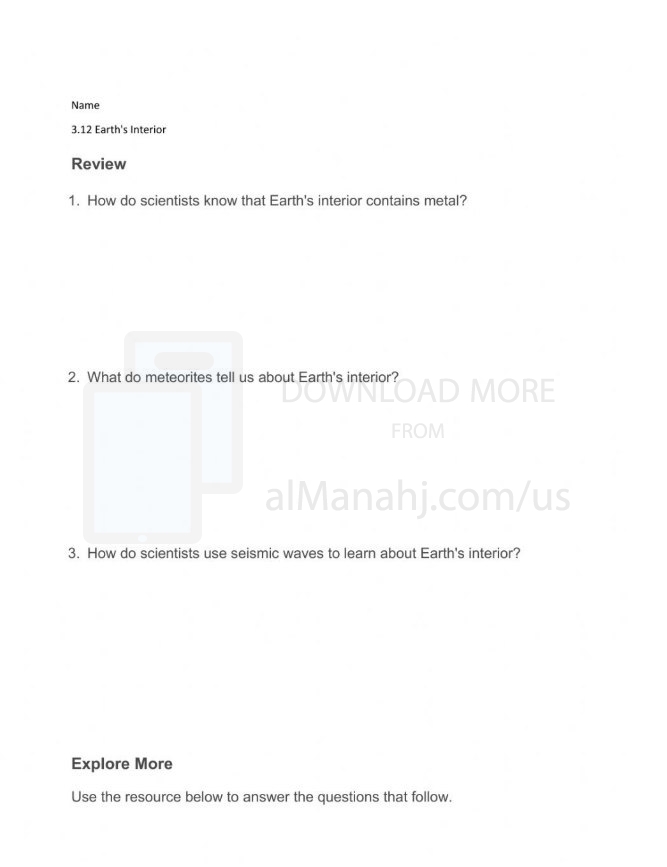| You are here: Almanahj Website ⇒ American curriculum ⇒ 10th Grade ⇒ Geology ⇒ Term 1 | ||
|---|---|---|
Worksheet about Earths Interior | ||
|---|---|---|
| Subject: Geology | ||
| 10th Grade | ||
| Term 1 | ||
| Year: 2023/2024 | ||
| Size: 176.8KB | ||
| Number of clicks: 112 | ||
| Publish date:November 28, 2023 | ||
| Added by: Eman | ||
| Last download date: 2024-09-08 10:09:24 | By: theodor Grace Vogt | |
| File info: The Earth's interior is divided into several layers, each with distinct characteristics. These layers are defined based on differences in composition, physical properties, and behavior. Here is a detailed overview of the Earth's interior layers: 1. Crust: The Earth's outermost layer is called the crust. It is the thinnest layer, ranging from about 5 to 70 kilometers (3 to 43 miles) in thickness. The crust is composed mainly of solid rocks, including various minerals and elements. There are two types of crust: continental crust, which is thicker and less dense, and oceanic crust, which is thinner and denser. 2. Mantle: Below the crust lies the mantle, which extends from the base of the crust to a depth of about 2,900 kilometers (1,800 miles). The mantle is the thickest layer of the Earth. It is primarily composed of solid rock, rich in iron and magnesium silicate minerals. The mantle is divided into the upper mantle and the lower mantle. The upper mantle is rigid and part of the lithosphere, while the lower mantle is more ductile and capable of slow flow over long periods of time. 3. Outer Core: Surrounding the mantle is the outer core, which extends from a depth of about 2,900 kilometers (1,800 miles) to approximately 5,150 kilometers (3,200 miles). The outer core is composed primarily of liquid iron and nickel. It is under extreme pressure and temperature conditions, which maintain the iron-nickel alloy in a liquid state. The outer core is responsible for generating the Earth's magnetic field through a process called geodynamo. 4. Inner Core: At the very center of the Earth is the inner core. It is a solid sphere with a radius of about 1,220 kilometers (760 miles). The inner core is composed mainly of solid iron and nickel. Despite the high temperatures, estimated to be around 5,000-6,000 degrees Celsius (9,000-10,800 degrees Fahrenheit), the immense pressure at the core keeps the iron-nickel alloy in a solid state. It's important to note that the boundaries between these layers are not sharp, but rather gradual transitions. The study of seismic waves, generated by earthquakes, has provided valuable information about the Earth's interior structure. By analyzing how these waves travel through the Earth and how they are reflected and refracted, scientists have been able to infer the properties and boundaries of the Earth's layers. The Earth's interior is a dynamic system, with processes such as mantle convection, plate tectonics, and heat transfer driving the movement and interactions of these layers. Understanding the Earth's interior is crucial for various scientific disciplines, including geology, seismology, and geophysics, as it provides insights into Earth's formation, evolution, and ongoing geological processes. | ||
| Downloading link Worksheet about Earths Interior |
|---|
|
1701148507.pdf
The file is being prepared for download
|
| File images |
|---|
 |